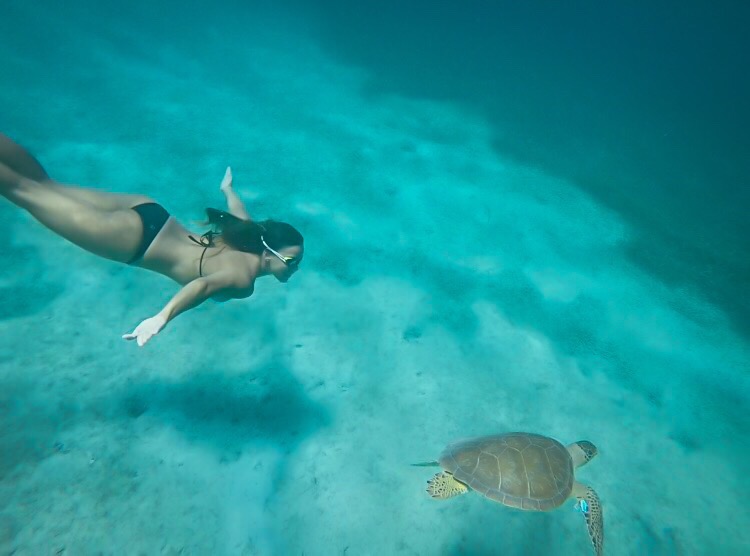Swimming with turtles in Australia
The Importance of Sea Turtles to Our Environment
The world's oceans have seven different species of sea turtles, six of which can be found in Australian waters. Not only are the sea turtles amazing to watch, but the oceans need these turtles to stay healthy.
Before you jump in with one of our Australian swimwear boutiques bikinis, there are a few things to know. Pollution and over-harvesting of turtle eggs threaten the sea turtles' existence. Coral reefs are diminishing, and seagrass beds and beaches used for nesting are being developed, leaving little room for the sea turtles.
Turtles are listed as endangered or vulnerable species and are protected under the Environment Protection and Biodiversity Conservation Act. The Australian government has a Recovery Plan to support sea turtles. But there is more to be done.
Why are the turtles so important?
Keystone Species. Sea turtles do more than just swim in our oceans. As a keystone species, they influence the behaviours of other animals in the oceans.
Eat Sponges. Some species of sea turtles eat sponges that grow on the coral reefs. Without turtles eating the sponges, they would grow to overwhelming numbers and suffocate the already delicate coral.
Keep Jellyfish Populations in Check. One of the sea turtles favourite snacks happens to be jellyfish. The leatherback species makes it a specialty. Without the leatherback's help, jellyfish would devour all of the ocean's larval fish.
Help with Beach Erosion. Sea turtles come on land to nest and lay eggs. When the eggs hatch, shells are left behind, providing nutrients for vegetation. In turn, the vegetation prevents coastal erosion of the beach.
These are just a few reasons the sea turtles are so crucial to our planet. They are revered by indigenous populations worldwide, they help other animals, and they eat seagrass. But to save the turtles, everyone must pitch in.

Photo by National Marine Sanctuaries
How can you help?
Reduce Rubbish. Sea turtles often get tangled up in debris. At times they've eaten it. Fishing hooks have been found in the stomachs of sea turtles, tearing up their insides. Pick up your trash. Make sure it gets to a proper landfill.
Reduce Plastics. Plastics quickly find their way to the oceans. Use a reusable water bottle. Make sure any plastic shopping bags you have end up in the recycle bin or use renewable bags.
Don't Disturb Nesting Areas. When you leave the beach for the day, take your chairs, umbrellas, and other beach equipment with you. Knockdown your sandcastles and fill in holes left on the beach. This gives turtles and hatchlings safe passage to the ocean, without scaring them away.
Smart Fishing. Recycle your fishing line and never abandon your fishing gear. Don't throw away your bait, as the sea turtles will start to associate the area as a feeding area and could get tangled in your lines. Likewise, don't feed the turtles.
Purchase Sustainable Australian Swimwear. Companies are now making sustainable swimwear from recycled plastic bottles and fishing nets. Buy your next swimming suit from Charlie Mae Swimwear and know we use sustainable fabrics.
These simple actions go a long way in helping sea turtles thrive. These charismatic animals are a source of inspiration for many. People love watching and swimming with these animals.

Photo by @ItalyAna
Swimming with the turtles.
And with all the wonderful experiences the world offers, there is nothing quite like swimming with a sea turtle for the first time. Grab your swimsuit and head to one of these places.
- Great Barrier Reef. From November to March, you can see the turtles and their hatchlings, making the journey ashore and back into the water to scurry away.
- Mon Repos. Sea turtles of all species enjoy the waters near Mon Repos. During the summer months, tours are even available so you can see the turtles.
- Ningaloo Reef. See loggerheads, hawksbill and flatback turtles in the waters by the reef during the months of December through March.
- Cook Island Marine Reserve. Turtles can be spotted year-round in this sanctuary. Green turtles and loggerhead turtles will be found nesting here from January to May.
- Broome and Eco Beach. Hotspots for turtle activity, the beaches of Broome have turtles nesting from October to February.
These amazing sea animals are vital to our oceans and our planet. Take a minute to help when you can, and be conscientious of the decisions you make. You can make a difference.
xx

